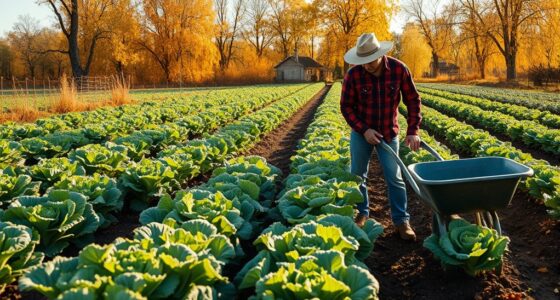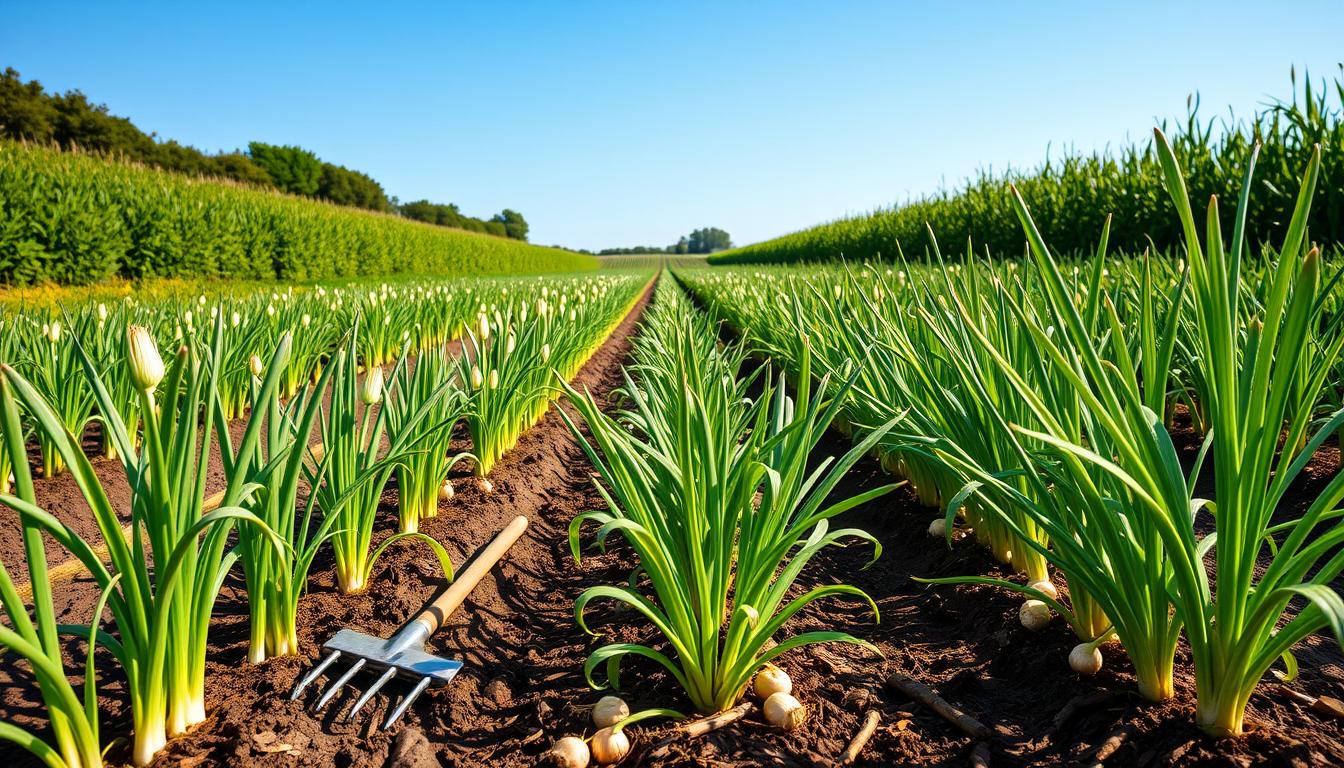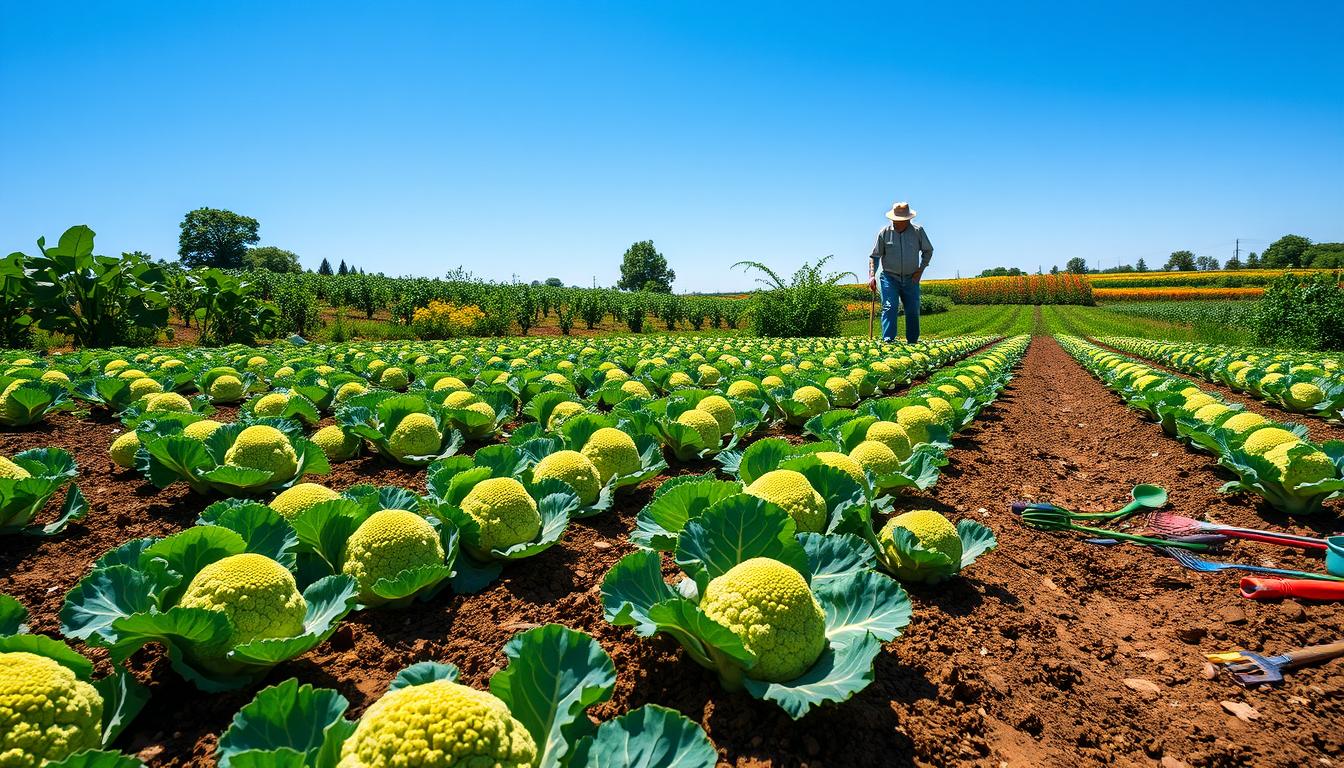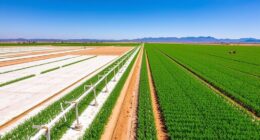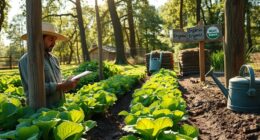To grow blueberries successfully, start with well-drained, acidic soil (pH 4.0-5.5) and enrich it with organic matter. Plant bushes 4-6 feet apart in early spring, making sure to keep the area clear of weeds. Water deeply, aiming for about 1 inch a week, and fertilize starting in the second year. Prune annually for healthy growth and harvest berries when fully blue and firm. Keep going to uncover more tips on caring for your blueberry plants.
Key Takeaways
- Blueberries require well-drained, acidic soil with a pH between 4.0 and 5.5; amend with organic matter for improved growth.
- Plant blueberry bushes in early spring, spacing them 4-6 feet apart, and ensure the area is free of weeds and debris.
- Water deeply, providing at least 1 inch weekly, increasing to 4 inches during fruit ripening to maintain optimal moisture levels.
- Prune bushes annually in late winter or early spring to remove damaged canes and encourage healthier growth and fruit production.
- Harvest blueberries when fully blue and springy, storing them in shallow containers in the refrigerator without washing until ready to use.
Understanding Blueberry Growing Needs
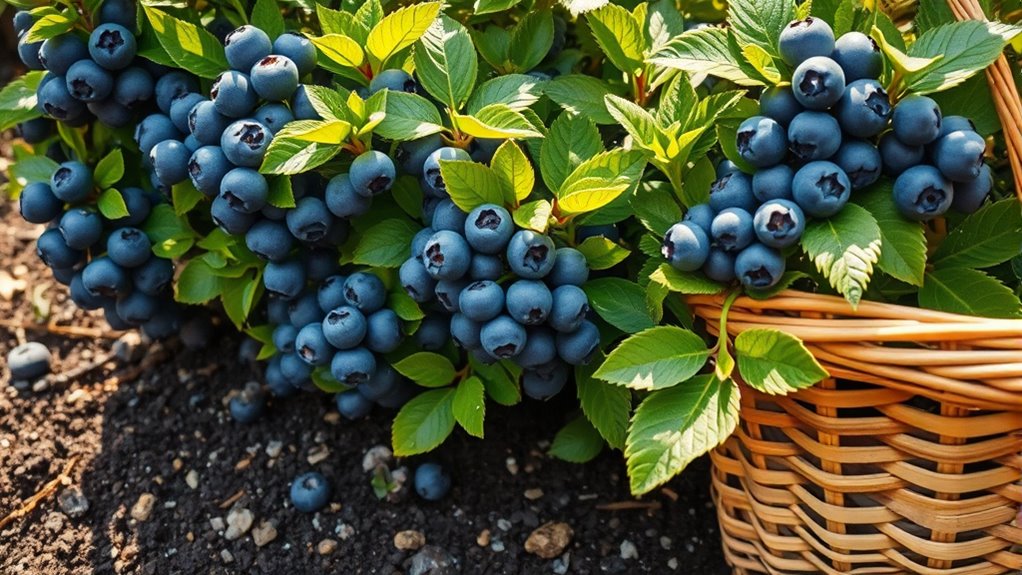
When you decide to grow blueberries, understanding their specific needs is vital for success.
Blueberries thrive in well-drained, acidic soil with a pH between 4.0 and 5.5. Planting them in enriched soil with organic matter, like peat moss, boosts their growth. Consistent moisture is imperative—aim for about 1 inch of water weekly, increasing to 4 inches during fruit ripening for larger berries.
Consider planting multiple varieties to enhance pollination and increase fruit production, even if some are self-pollinating. Regular pruning after a few years keeps your bushes healthy; remove damaged canes and promote new growth.
Preparing Soil for Blueberries
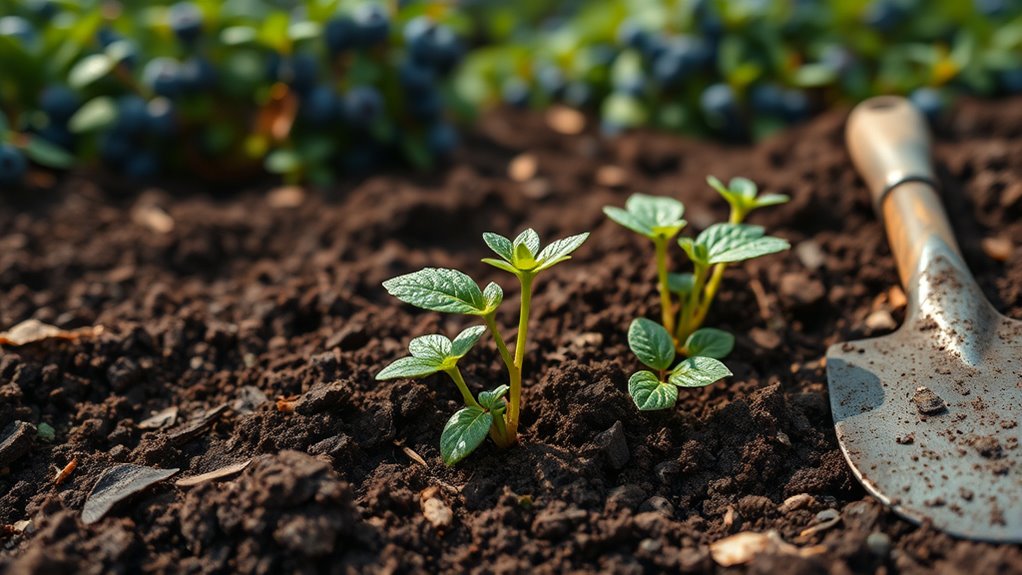
Before planting blueberries, you need to test your soil's pH to guarantee it's acidic enough for ideal growth.
If your soil's pH isn't in the 4.0 to 5.2 range, you'll have to amend it, often using elemental sulfur.
Additionally, adding organic matter is essential, as it helps retain moisture and supports the healthy development of your blueberry plants.
Testing Soil Ph
To guarantee your blueberries flourish, testing the soil pH is vital, as these plants thrive best in acidic conditions between 4.0 and 5.0.
Conduct a soil pH test before blueberries will be planted to ascertain the soil meets their requirements. You can use inexpensive soil test kits from local extension offices or opt for professional soil testing for more accurate results.
If your soil pH is above 5.5, consider using elemental sulfur as a soil acidifier to lower the pH, allowing 6 months to 2 years for effective acidification.
Regular monitoring of soil pH is essential, as maintaining low pH levels guarantees the acidic environment blueberries need.
Avoid compost high in nitrogen, which can disrupt the soil moisture balance.
Amending Soil Acidity
Amending soil acidity is key for successful blueberry cultivation, especially after determining your soil's pH.
Blueberry plants thrive in acidic soil with a pH range of 4.0 to 5.5, so if your soil test reveals a pH above 5.5, use elemental sulfur to lower acidity. This process can take 6 months to 2 years, as natural bacteria work to acidify soil.
Incorporate organic materials like peat moss at a ratio of 40% peat, 10% compost, and 50% native soil to enhance both soil texture and acidity. Be sure to regularly monitor soil pH, as blueberries are sensitive to fluctuations.
Avoid using high-nitrogen composts, as they can harm your plants due to elevated nitrogen levels.
Organic Matter Importance
While preparing your soil for blueberries, incorporating organic matter is essential for fostering healthy growth.
Blueberry bushes thrive in a mixture rich in organic matter, which retains moisture and provides important nutrients. A recommended blend is 40% peat moss, 10% compost, and 50% native soil.
Peat moss helps lower soil pH, creating the acidic soil blueberries need while improving drainage and texture for root development.
Avoid using mushroom compost or composted manure due to their high nitrogen content, which can harm your plants.
Regular soil testing is critical to monitor pH levels, ensuring your organic amendments effectively support the long-term health of your blueberry bushes.
Prioritize organic matter for the best results!
Planting Blueberry Bushes
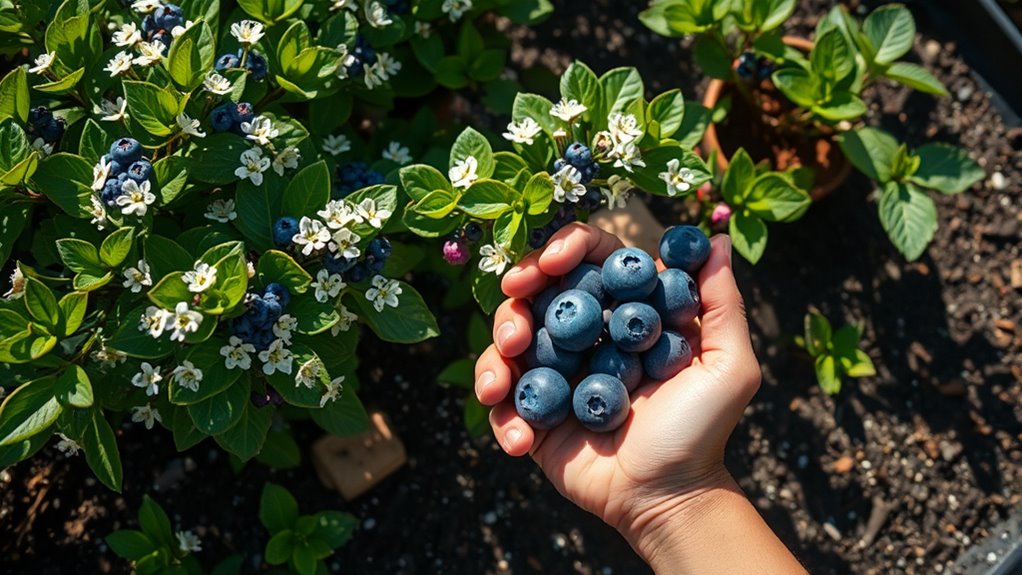
When you plant blueberry bushes, timing and soil preparation are key for healthy growth.
Aim for early spring and make sure your soil is well-drained and acidic, ideally with a pH between 4.0 and 5.2.
With the right conditions, your bushes will thrive and produce delicious berries for years to come.
Ideal Planting Conditions
To grow healthy blueberry bushes, you need to make certain they're planted in ideal conditions. Here are three key factors to take into account:
- Soil: Blueberries prefer well-draining, acidic soil with a pH between 4.0 and 5.2. If your soil is too alkaline, think about adding amendments like elemental sulfur.
- Water: After planting your highbush blueberries, soak the roots for 3-6 hours. Water each bush with 1-2 gallons immediately, and maintain at least 1 inch of water weekly, increasing to 4 inches during fruit ripening.
- Space: Plant multiple bushes 4-6 feet apart to make certain proper root development and enhance cross-pollination.
Proper Soil Preparation
Preparing the soil properly is essential for the success of your blueberry bushes. Start by testing your soil's pH level; blueberries thrive in acidic soil with a pH between 4.0 and 5.0. If needed, amend with elemental sulfur to lower the pH.
Next, clear the planting area of weeds, rocks, and roots to minimize weed competition, ensuring your bushes have a competition-free environment. For a well-drained, organic-rich planting medium, mix 40% peat moss, 10% compost, and 50% native soil, avoiding high-nitrogen amendments.
Space your blueberry bushes 4-6 feet apart for proper air circulation. Finally, water each bush with 1-2 gallons immediately after planting to support root establishment and maintain consistently moist soil, especially during the first year.
Watering and Mulching Techniques
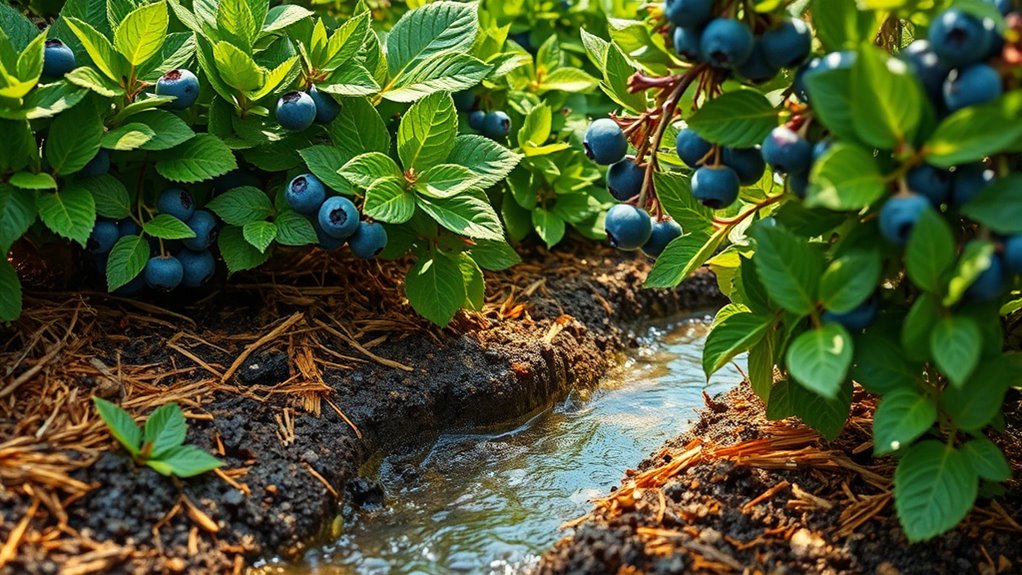
Proper watering and mulching techniques are essential for growing healthy blueberries, as these plants thrive in consistently moist, acidic conditions.
To guarantee your blueberry shrubs flourish, follow these tips:
- Deep Watering: Water your blueberries deeply, aiming for about 1 inch per week, increasing to 4 inches during fruit ripening to enhance size and flavor.
- Mulching: Use low pH materials like peat moss or pine needles to conserve moisture and maintain acidic soil conditions.
- Soil Moisture Check: Regularly check soil moisture, keeping it similar to a wrung-out sponge to avoid drought stress and prevent root rot.
Water during the day to reduce fungal diseases, making certain the soil remains moist but not soggy for maximum growth.
Fertilizing and Pruning Blueberries
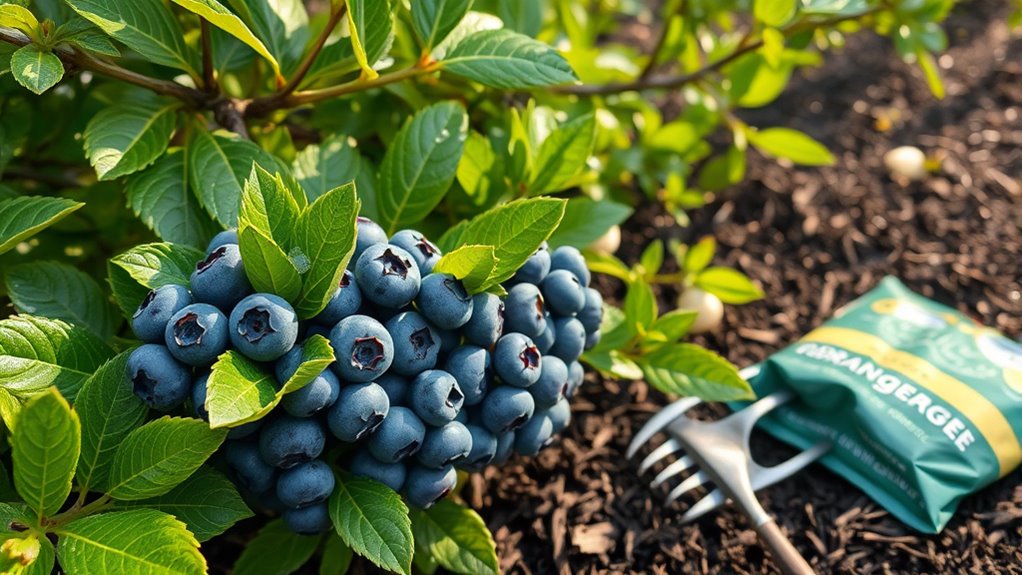
While blueberries are relatively low-maintenance, understanding how to fertilize and prune them effectively is key to maximizing their growth and fruit quality.
Don't fertilize blueberry bushes in their first year. Starting in the second year, use ammonium sulfate or a balanced 10-10-10 fertilizer in split doses as buds open in spring and a month later. Avoid over-fertilization; a yearly application of organic nitrogen sources like soybean meal or alfalfa meal is enough.
Avoid fertilizing blueberry bushes in their first year; start in year two with careful, split applications for optimal growth.
Prune your bushes only to remove damaged canes during the first 2-3 years. After that, prune annually in late winter or early spring to encourage new growth, focusing on older stems.
Regularly monitor soil pH, adjusting with elemental sulfur to maintain the ideal acidic range for blueberries.
Protecting Blueberries From Pests and Wildlife

To guarantee a bountiful harvest of blueberries, you need to protect your bushes from pests and wildlife that can decimate your crop. Here are some effective protective measures:
- Use heavy-duty netting to shield ripening berries from birds, ensuring it's securely fastened at the base to prevent access.
- Construct a Blueberry Temple using metal mesh to deter larger wildlife like deer and raccoons from feasting on your bushes.
- Monitor for signs of wildlife presence, such as droppings or damaged plants, to inform your protective measures.
Additionally, utilize Tangle Trap to manage pests like blueberry maggot and spotted wing drosophila.
Regularly inspect for signs of infestations or diseases, including mummy berry fungus, to keep your blueberries thriving.
Harvesting and Storing Your Blueberries
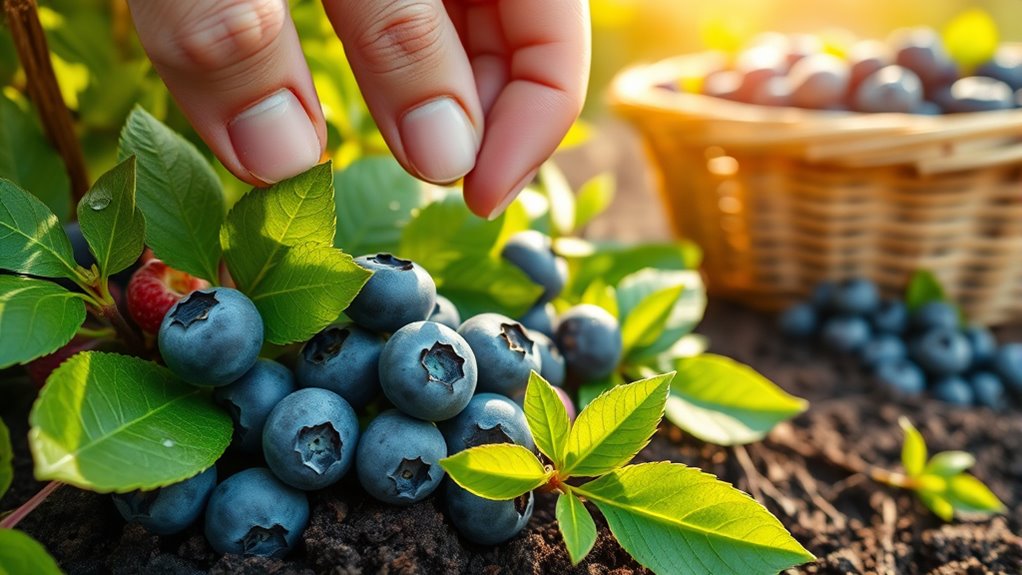
Harvesting blueberries at the right time is essential for enjoying their maximum sweetness and flavor. Wait until the berries are fully blue and springy to the touch, typically 3-7 days after they turn blue, for the best taste.
Harvest blueberries at their peak, waiting 3-7 days after they turn fully blue for the sweetest flavor.
When harvesting blueberries, gently pull the ripe berries off the plant, leaving some stems attached to prevent overripe berries from dropping.
To store harvested blueberries, place them in a shallow container in the refrigerator, avoiding deep layering to prevent crushing. Remember to avoid washing them until you're ready to use them to minimize mold growth.
For ideal freshness, consume blueberries within 3-5 days, but with proper storage, they can last up to 7-10 days. If you're freezing blueberries, wash and dry them first.
Frequently Asked Questions
How Do You Maintain Blueberry Soil?
To maintain blueberry soil, you need to regularly test the pH, aiming for that ideal range of 4.0 to 5.5.
If it's too high, amend it with elemental sulfur and allow time for the changes. Incorporate organic matter like peat moss for better drainage and acidity.
Keep the soil consistently moist, and apply a thick layer of mulch to retain moisture, suppress weeds, and protect the roots from temperature changes.
What Is the Secret to Growing Blueberries?
The secret to growing blueberries isn't just a whisper; it's a symphony of care.
You need to start with acidic soil, aiming for a pH between 4.0 and 5.2. Consistent moisture is key, so make sure you're watering weekly.
Planting multiple varieties boosts pollination, while annual pruning keeps your bushes healthy.
Don't forget to protect those ripening berries from pests; they're like tiny ninjas ready to steal your sweet rewards!
What Does Epsom Salt Do for Blueberries?
Epsom salt boosts blueberry growth by providing magnesium, essential for photosynthesis and overall plant health.
When you apply it, you enhance fruit quality and yield as magnesium aids in cell structure and chlorophyll production.
For best results, you should dissolve one tablespoon of Epsom salt per foot of plant height in water and apply it in early spring and after harvest.
Just be careful not to overdo it, as too much magnesium can harm your plants.
What Not to Plant Next to Blueberries?
Did you know that blueberries can yield up to 10,000 pounds per acre under ideal conditions?
To guarantee your blueberry plants thrive, don't plant them next to crops like tomatoes, potatoes, or asparagus. These plants compete for nutrients and can alter soil pH, harming your blueberries.
Also, steer clear of invasive species like mint and perennial weeds that can outcompete your blueberries for moisture and space, impacting their growth and yield.
Conclusion
Growing blueberries is like nurturing a friendship; it takes patience, care, and the right environment to flourish. As you've learned, preparing the soil and providing proper care can lead to a bountiful harvest. Just like a good friend, your blueberry bushes will reward your effort with sweet, juicy berries. So, dig in, embrace the process, and soon you'll be enjoying the fruits of your labor—quite literally—one delicious bite at a time. Happy gardening!



